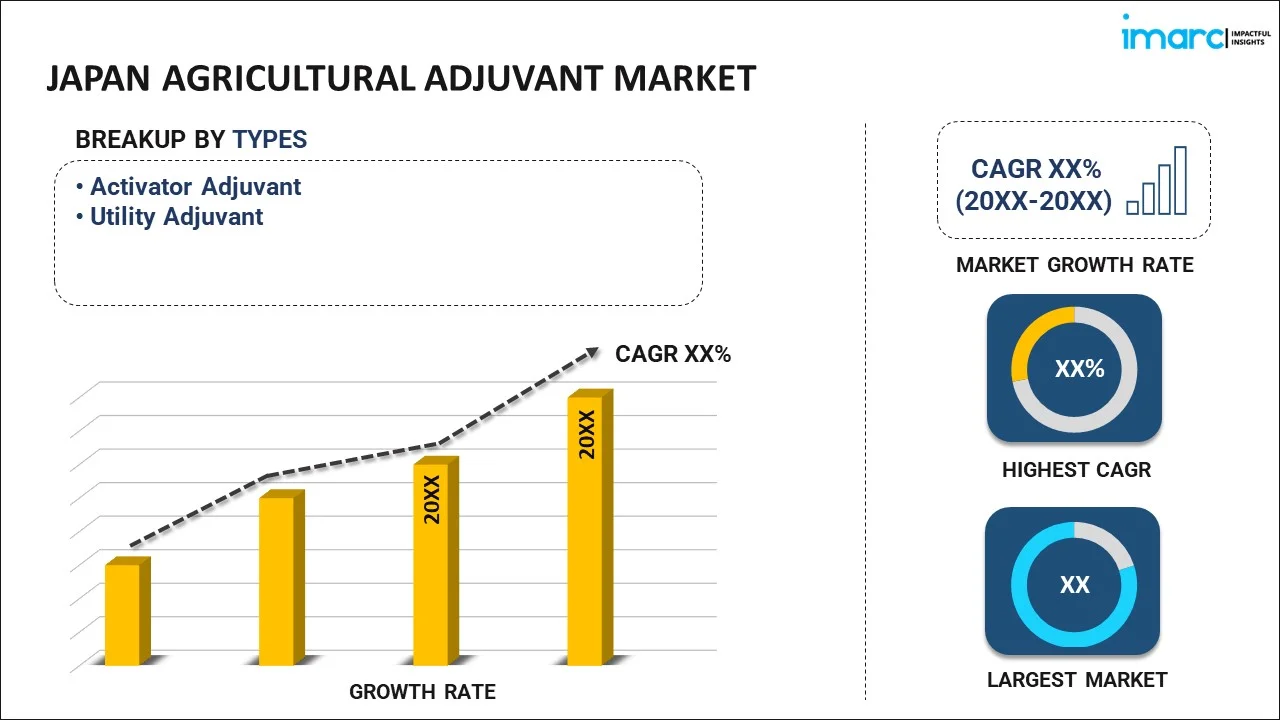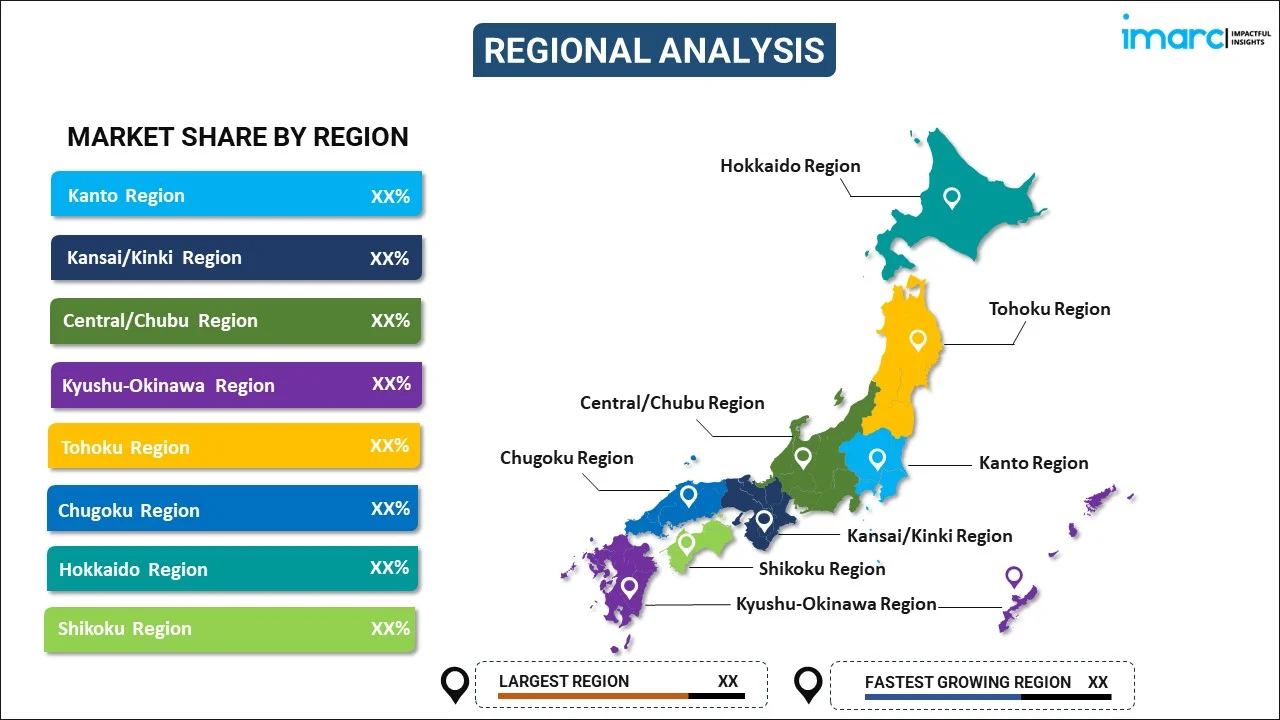
Japan Agricultural Adjuvant Market Report by Type (Activator Adjuvant, Utility Adjuvant), Crop Type (Cereals and Oilseeds, Fruits and Vegetables, and Others), Application (Herbicides, Fungicides, Insecticides, and Others), and Region 2025-2033
Market Overview:
Japan agricultural adjuvant market size reached USD 220.8 Million in 2024. Looking forward, IMARC Group expects the market to reach USD 331.0 Million by 2033, exhibiting a growth rate (CAGR) of 4.2% during 2025-2033. The emerging trend towards sustainable and eco-friendly farming practices, which utilize adjuvants to reduce the environmental impact of farming by improving the targeting and efficiency of chemicals, is driving the market.
|
Report Attribute
|
Key Statistics
|
|---|---|
|
Base Year
|
2024
|
|
Forecast Years
|
2025-2033
|
|
Historical Years
|
2019-2024
|
|
Market Size in 2024
|
USD 220.8 Million |
|
Market Forecast in 2033
|
USD 331.0 Million |
| Market Growth Rate 2025-2033 | 4.2% |
Agricultural adjuvants are substances or additives used in farming practices to enhance the effectiveness of pesticides, herbicides, or fertilizers. They play a crucial role in improving the overall performance of these agricultural inputs. Adjuvants can be classified into several categories, including surfactants, oils, emulsifiers, and spreader-stickers, among others. Surfactants are perhaps the most common type of agricultural adjuvants, as they reduce the surface tension of liquids, allowing them to spread more evenly across plant surfaces. This helps pesticides and herbicides adhere to target plants, increasing their efficacy. Oils can act as carriers for certain chemicals, ensuring better penetration into plant tissues. Emulsifiers help mix water-based and oil-based solutions, improving the compatibility of different agricultural products. In summary, agricultural adjuvants are essential tools for modern farming, as they enable farmers to maximize the effectiveness of crop protection and nutrient delivery methods. By enhancing the dispersion, adhesion, and absorption of agricultural chemicals, adjuvants contribute to higher crop yields and more sustainable agricultural practices.
Japan Agricultural Adjuvant Market Trends:
The agricultural adjuvant market in Japan is experiencing robust growth, driven by several key factors. Firstly, the increasing regional population necessitates higher agricultural productivity, which, in turn, boosts the demand for adjuvants. Additionally, changing climate patterns and the need for sustainable agriculture practices have led to a greater focus on precision farming and the adoption of advanced agrochemicals, further propelling the market forward. Moreover, the growing awareness of environmental concerns and the need to minimize pesticide and fertilizer usage has prompted farmers to seek out adjuvants that enhance the efficacy of these inputs, thus reducing their environmental impact. This, in conjunction with stringent regulations on pesticide usage, has fostered the development and adoption of environmentally friendly adjuvants. Furthermore, advancements in biotechnology and genetic engineering, which have led to the development of new crop varieties requiring specialized adjuvants to optimize their performance, are expected to drive the agricultural adjuvant market in Japan during the forecast period.
Japan Agricultural Adjuvant Market Segmentation:
IMARC Group provides an analysis of the key trends in each segment of the market, along with forecasts at the country level for 2025-2033. Our report has categorized the market based on type, crop type, and application.
Type Insights:

- Activator Adjuvant
- Utility Adjuvant
The report has provided a detailed breakup and analysis of the market based on the type. This includes activator adjuvant and utility adjuvant.
Crop Type Insights:
- Cereals and Oilseeds
- Fruits and Vegetables
- Others
A detailed breakup and analysis of the market based on the crop type have also been provided in the report. This includes cereals and oilseeds, fruits and vegetables, and others.
Application Insights:
- Herbicides
- Fungicides
- Insecticides
- Others
The report has provided a detailed breakup and analysis of the market based on the application. This includes herbicides, fungicides, insecticides, and others.
Regional Insights:

- Kanto Region
- Kansai/Kinki Region
- Central/ Chubu Region
- Kyushu-Okinawa Region
- Tohoku Region
- Chugoku Region
- Hokkaido Region
- Shikoku Region
The report has also provided a comprehensive analysis of all the major regional markets, which include Kanto Region, Kansai/Kinki Region, Central/ Chubu Region, Kyushu-Okinawa Region, Tohoku Region, Chugoku Region, Hokkaido Region, and Shikoku Region.
Competitive Landscape:
The market research report has also provided a comprehensive analysis of the competitive landscape in the market. Competitive analysis such as market structure, key player positioning, top winning strategies, competitive dashboard, and company evaluation quadrant has been covered in the report. Also, detailed profiles of all major companies have been provided.
Japan Agricultural Adjuvant Market Report Coverage:
| Report Features | Details |
|---|---|
| Base Year of the Analysis | 2024 |
| Historical Period | 2019-2024 |
| Forecast Period | 2025-2033 |
| Units | Million USD |
| Scope of the Report | Exploration of Historical and Forecast Trends, Industry Catalysts and Challenges, Segment-Wise Historical and Predictive Market Assessment:
|
| Types Covered | Activator Adjuvant, Utility Adjuvant |
| Crop Types Covered | Cereals and Oilseeds, Fruits and Vegetables, Others |
| Applications Covered | Herbicides, Fungicides, Insecticides, Others |
| Regions Covered | Kanto Region, Kansai/Kinki Region, Central/ Chubu Region, Kyushu-Okinawa Region, Tohoku Region, Chugoku Region, Hokkaido Region, Shikoku Region |
| Customization Scope | 10% Free Customization |
| Post-Sale Analyst Support | 10-12 Weeks |
| Delivery Format | PDF and Excel through Email (We can also provide the editable version of the report in PPT/Word format on special request) |
Key Questions Answered in This Report:
- How has the Japan agricultural adjuvant market performed so far and how will it perform in the coming years?
- What has been the impact of COVID-19 on the Japan agricultural adjuvant market?
- What is the breakup of the Japan agricultural adjuvant market on the basis of type?
- What is the breakup of the Japan agricultural adjuvant market on the basis of crop type?
- What is the breakup of the Japan agricultural adjuvant market on the basis of application?
- What are the various stages in the value chain of the Japan agricultural adjuvant market?
- What are the key driving factors and challenges in the Japan agricultural adjuvant?
- What is the structure of the Japan agricultural adjuvant market and who are the key players?
- What is the degree of competition in the Japan agricultural adjuvant market?
Key Benefits for Stakeholders:
- IMARC’s industry report offers a comprehensive quantitative analysis of various market segments, historical and current market trends, market forecasts, and dynamics of the Japan agricultural adjuvant market from 2019-2033.
- The research report provides the latest information on the market drivers, challenges, and opportunities in the Japan agricultural adjuvant market.
- Porter's five forces analysis assist stakeholders in assessing the impact of new entrants, competitive rivalry, supplier power, buyer power, and the threat of substitution. It helps stakeholders to analyze the level of competition within the Japan agricultural adjuvant industry and its attractiveness.
- Competitive landscape allows stakeholders to understand their competitive environment and provides an insight into the current positions of key players in the market.
Need more help?
- Speak to our experienced analysts for insights on the current market scenarios.
- Include additional segments and countries to customize the report as per your requirement.
- Gain an unparalleled competitive advantage in your domain by understanding how to utilize the report and positively impacting your operations and revenue.
- For further assistance, please connect with our analysts.
 Inquire Before Buying
Inquire Before Buying
 Speak to an Analyst
Speak to an Analyst
 Request Brochure
Request Brochure
 Request Customization
Request Customization




.webp)




.webp)












